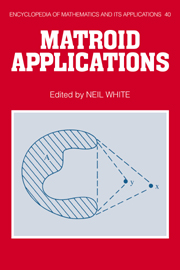Book contents
- Frontmatter
- Contents
- List of Contributors
- Preface
- 1 Matroids and Rigid Structures
- 2 Perfect Matroid Designs
- 3 Infinite Matroids
- 4 Matroidal Families of Graphs
- 5 Algebraic Aspects of Partition Lattices
- 6 The Tutte Polynomial and Its Applications
- 7 Homology and Shellability of Matroids and Geometric Lattices
- 8 Introduction to Greedoids
- Index
1 - Matroids and Rigid Structures
Published online by Cambridge University Press: 19 March 2010
- Frontmatter
- Contents
- List of Contributors
- Preface
- 1 Matroids and Rigid Structures
- 2 Perfect Matroid Designs
- 3 Infinite Matroids
- 4 Matroidal Families of Graphs
- 5 Algebraic Aspects of Partition Lattices
- 6 The Tutte Polynomial and Its Applications
- 7 Homology and Shellability of Matroids and Geometric Lattices
- 8 Introduction to Greedoids
- Index
Summary
Many engineering problems lead to a system of linear equations a represented matroid - whose rank controls critical qualitative features of the example (Sugihara, 1984; 1985; White & Whiteley, 1983). We will outline a selection of such matroids, drawn from recent work on the rigidity of spatial structures, reconstruction of polyhedral pictures, and related geometric problems.
For these situations, the combinatorial pattern of the example determines a sparse matrix pattern that has both a generic rank, for general ‘independent’ values of the non-zero entries, and a geometric rank, for special values for the coordinates of the points, lines, and planes of the corresponding geometric model. Increasingly, the generic rank of these examples has been studied by matroid theoretic techniques. These geometric models provide nice illustrations and applications of techniques such as matroid union, truncation, and semimodular functions. The basic unsolved problems in these examples highlight certain unsolved problems in matroid theory. Their study should also lead to new results in matroid theory.
Bar Frameworks on the Line - the Graphic Matroid
We begin with the simplest example, which will introduce the vocabulary and the basic pattern. We place a series of distinct points on a line, and specify certain bars - pairs of joints which are to maintain their distance - defining a bar framework on the line. We ask whether the entire framework is ‘rigid’ - i.e. does any motion of the joints along the line, preserving these distances, give all joints the same velocity, acceleration, etc.? Clearly a framework has an underlying graph G = (V, E), with a vertex vi for each joint Pi and an undirected edge {i, j} for each bar {pi, pj}.
- Type
- Chapter
- Information
- Matroid Applications , pp. 1 - 53Publisher: Cambridge University PressPrint publication year: 1992
- 22
- Cited by



